New York State Wine History
– Thomas Jefferson
Hospitable climate conditions and an abundance of native grape species made New York State a natural home for several historic wine companies, with many still in operation today in their original locations. New York State’s wine industry was one of the first in the nation to begin producing quality New World wines on a large scale. The state is home to nine designated American Viticultural Areas which encompass 40,000 acres of vineyards. The wineries in New York now produce around 20 million gallons of wine a year, fourth in the country behind California, Oregon, and Washington.
| Brotherhood Winery. Photographs, ca. 1920-1930.
Brotherhood Winery is America’s oldest continuously operating winery, designated U.S. Bonded Winery #2. Located in Washingtonville, New York in the Hudson River Valley, the company produced its first commercial vintage in 1839. These photographs document a portion of the sparkling wine making process at Brotherhood in the 1920s. |
|
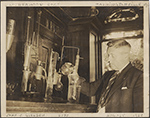 |
This photograph shows a wine maker conducting laboratory tests. The chemistry of the fermentation process, sugar, alcohol, acidity, and carbon dioxide levels are all examples of what a technician might analyze in the lab. [zoom] |
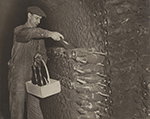 |
To make sparkling wine, wine makers pour grape juice that has been fermented in open vats into bottles. These full bottles rest in the wine cellar, where they complete the fermentation process. A mixture of sugar and yeast, or tirage, is added to the bottles. The fermentation process creates the carbon dioxide, or bubbles, that define sparkling wine. [zoom] |
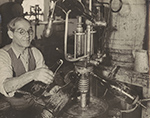 |
After resting for several months, each bottle is unsealed. Pressure in the bottle pushes sediment, created during the fermentation process, out of the bottle. The small amount of wine lost when this sediment is removed is replaced with a “dosage” of wine, sometimes incorporating sugar or brandy, to finish the bottle. This photograph shows the dosage process. [zoom] |
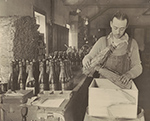 |
Breakage of wine bottles during shipment has always been a hazard for wine makers. Using straw to protect bottles during storage and shipping was an inexpensive way to limit damage. [zoom] |
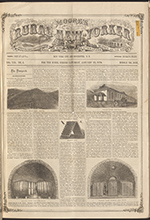 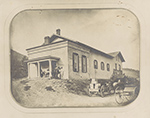 |
Pleasant Valley Wine Company in Moore’s Rural New Yorker. January 22, 1870. [zoom] | View/download a PDF of this item Pleasant Valley Wine Company. Photograph, ca. 1865. The Pleasant Valley Wine Company was founded on March 15, 1860 in Hammondsport, New York. It is U.S. Bonded Winery #1. Charles Davenport Champlin established the winery in partnership with other local grape growers. The company grew quickly by hiring wine makers who would prove influential in America’s early sparkling wine industry, such as DeWitt Clinton Bauder and French champagne masters Joseph and Jules Masson. Pleasant Valley’s Great Western Champagne brand was soon served in cities throughout the east coast. Bauder is shown in this photograph at the far left of the porch. |
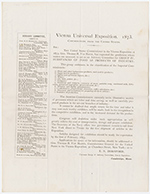 |
Vienna World Exposition. Exhibition Reservation Form and Letter from E. N. Horsford to Charles Champlin, January 2, 1873. [zoom] | Additional images:  
After gaining popularity in the United States, the Pleasant Valley Wine Company began entering its products in international expositions. At the 1867 World Exposition in Paris, its champagne became the first American wine ever recognized in European competition. Six years later, at the Vienna Exposition, Pleasant Valley’s champagne took home first prize, becoming the first United States wine to win a medal in international competition. An image of a gold medal was featured on Pleasant Valley champagne labels for many years. This entry form and letter document Pleasant Valley’s participation in the 1873 Vienna Exposition. E. N. Horsford was chairman of the Exposition’s advisory committee. Another member of the committee was George Caldwell, the first chemistry professor at Cornell University and namesake of Caldwell Hall. In this letter, Horsford discourages Champlin from doing anything that would influence a judge’s decision, and notes that the entry is for the sake of national pride. American wines continue to prove themselves on the world stage today. |
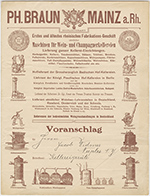 |
Wine Equipment Brochure. Germany, ca. 1900. [zoom] With many of New York’s early winemakers coming from Europe, it is no surprise that relationships with European companies were common. John Jacob Widmer moved to Naples, New York from Switzerland, founding Widmer Wine Cellars in 1888. As this brochure shows, he purchased winemaking supplies and equipment from P.H. Braun in Mainz, Germany. Right down the road from Widmer, the Pleasant Valley Wine Company was importing bottles, champagne cages, and corks from France. Until the United States wine industry had created enough demand to support the manufacture of domestic supplies, American wineries had no choice but to import what they needed from Europe. Even today, many wineries will purchase certain supplies from overseas if owners feel the benefits of superior quality outweigh what are typically higher costs of importation. |
 |
New York State Wine Publicity, ca. 1900-1920. [zoom] | Additional images:    
Winemakers relied on flyers, postcards, and magazine advertising to publicize the virtues of early New York wines. The wines were sometimes transported by railway tank cars, which may explain why the New York White Tokay label states that the wine was bottled in Michigan. |
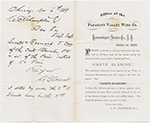 |
Carte Blanche Pleasant Valley Wine Company. Advertising Flyer and Order Request, 1869. [zoom] |
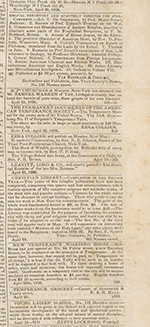 |
Samuel Warren Wine Advertisement in The New-York Evangelist. April 30, 1836. [zoom] Buried within the classified pages of the New-York Evangelist newspaper, this small advertisement is perhaps the earliest documentation of commercial scale wine production in New York State. |